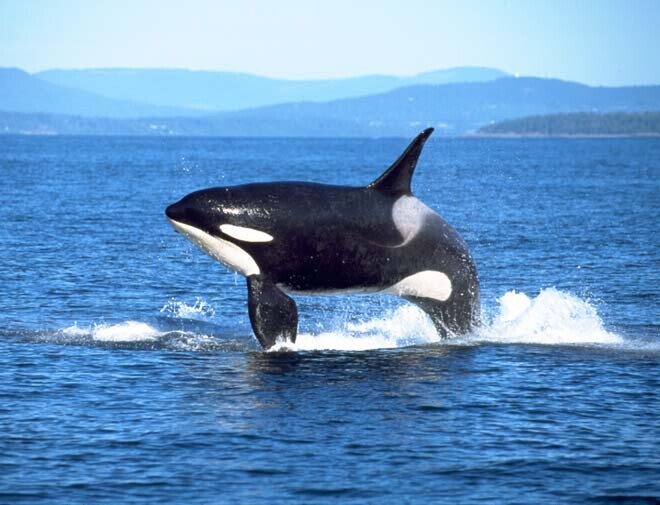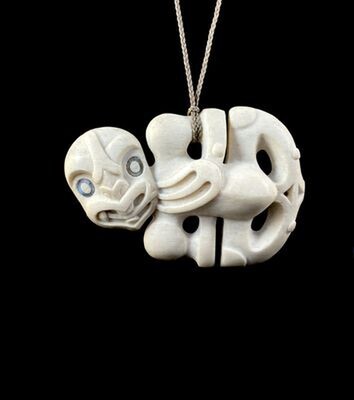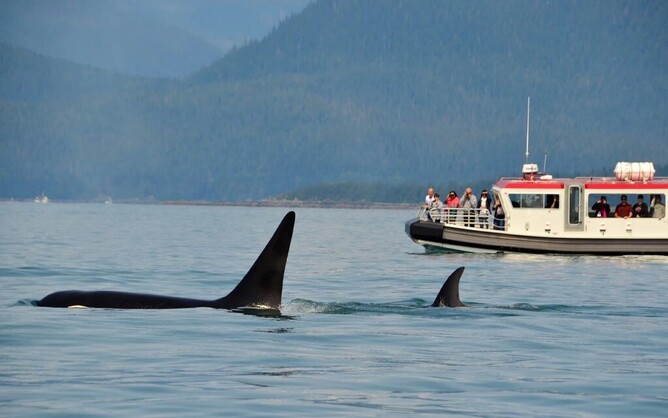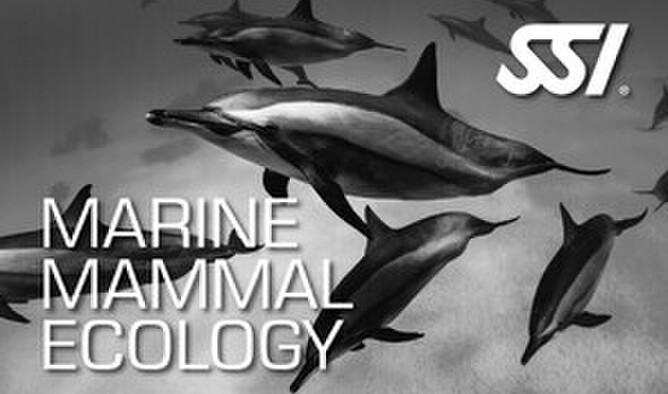The majestic Orca of Aotearoa
Aotearoa (New Zealand) is known for its breathtaking landscapes, rich biodiversity, and unique wildlife. Among the many awe-inspiring creatures that call these waters home, orca whales stand out as some of the most majestic and intelligent marine mammals. With their distinctive black and white markings and formidable presence, orcas, also known as killer whales, capture the imagination of people around the world. This blog post explores the fascinating world of orca whales in Aotearoa (New Zealand), shedding light on their behavior, population, conservation efforts, and the best places to witness these magnificent creatures.
Natural Habitat and Distribution:
Aotearoa's extensive coastline, diverse marine ecosystems, and abundance of food sources make it an ideal habitat for orca whales. Found in both the coastal waters and open oceans, these magnificent creatures often migrate around the country, following their prey such as fish, squid, and seals. The coastal waters of North Island, particularly the Bay of Islands, Bay of Plenty, the Hauraki Gulf, and the Marlborough Sounds, are renowned hotspots for orca sightings. Off the coast of South Island, Kaikōura and Fiordland National Park are also fantastic destinations to spot these majestic marine creatures.
Identification:
Spotting an Orca in its natural habitat is something special, and identification is relatively easy if you know what to look for.
The killer whale/orca (Orcinus orca) can be identified relatively easily by its distinctive black and white body markings and a very tall, prominent dorsal fin. They can grow in excess of 9 meters in length, with the male dorsal fins reaching more than a metre in height. Orca flippers are large and paddle-shaped and overall the body is very muscular in appearance. Females and males differ in that males are longer and bulkier than females and females have smaller, more curved dorsal fins, and smaller flippers.
Behavior and Social Structure:
Orcas are highly social animals that live in complex family groups called pods. A typical pod consists of a female orca, her offspring, and related individuals. These pods exhibit distinct dialects, feeding techniques, and hunting strategies, passed down through generations. Known for their intelligence, cooperative hunting, and sophisticated communication, orcas are truly remarkable creatures. They are also known for their acrobatic displays, breaching, tail-slapping, and spy-hopping, all of which make for an unforgettable sight for those lucky enough to witness them.
Cultural Significance of Orcas in Aotearoa
Māori people have a profound connection to the land and sea and a spiritual bond to the Orca. The Orca, also known as tūpuna, holds a special place in Māori culture, representing strength, protection, and a connection to the spiritual world.
For Māori people, the orca is seen as a guardian of the sea, protecting their communities and guiding them through turbulent waters. According to Māori legend, the orca was honored as a deity named Tangaroa, the god of the sea. Tangaroa, in Māori mythology, was one of the most powerful and revered gods, holding dominion over all aquatic creatures. The orca, being the largest and most powerful predator in Aotearoa waters, is believed to be Tangaroa's most loyal servant and protector.
The cultural significance of orcas is vividly depicted in Māori art and carvings. These intricate and symbolic carvings, often found on meeting houses and ceremonial objects, pay homage to Māori's spiritual relationship with the orca. The distinctive markings of the orca, with its black and white coloration, are replicated in these carvings, symbolizing strength, unity, and the balance between land and sea.
In Māori culture, the orca is also revered for its role as a navigational aid. The tūpuna, as they are called, are believed to guide seafarers through treacherous waters, assisting with safe navigation and providing protection on their voyages. Māori have long relied on the knowledge and wisdom of the orca to navigate their way along Aotearoa's rugged coastlines, and to this day, traditional knowledge is passed down through generations to honor these celestial creatures.
Māori concept of whānau (family), extends beyond just human kinship. It encompasses a deep sense of interconnectedness with the natural world, including animals and even geographical landmarks. The orca is considered part of the Māori whānau, and its presence is seen as a sign of unity and protection. This connection is further reinforced through traditional storytelling and oral histories, where the orca often features as a key ancestor or guide.
Whale bone has played a fundamental role in Māori culture for generations. Historically, Māori used various parts of the whale for practical purposes, including the bones, teeth, baleen, and oils. These precious resources were highly valued and utilized in a wide range of applications, such as crafting tools, weapons, jewelry, and ceremonial objects.
Within Māori society, whale bone became a symbol of prestige and status. The skilled manipulation of these materials required expert craftsmanship, and those who possessed the knowledge and ability to work with whale bone were highly regarded. The intricately carved whale bone artifacts, known as whakairo, served as prized possessions and markers of social standing.
Whale bone holds a strong connection to ancestral traditions and stories within Māori culture. Māori people believe in the concept of whakapapa, which emphasises genealogical connections between humans, the natural world, and their ancestors. The use of whale bone in ceremonial objects and carvings allows Māori to honor and pay respect to their lineage, as well as connect with the spiritual realm of their tūpuna (ancestors).
Māori regard whale bone artifacts as taonga, meaning treasures or heirlooms. These objects are often passed down through generations, symbolizing a deep connection to one's whakapapa and family history. The preservation of these taonga serves as a reminder of the Māori's ancestral ties, cultural heritage, and traditional values that continue to shape their identity.
Orca Conservation in Aotearoa
Despite being icons of the ocean, orcas face numerous threats, both natural and anthropogenic. Historically, orca were targeted by fishermen for human consumption but no significant hunting occurs today. Nowadays, one of the greatest potential impacts is likely to be disturbance caused by vessel traffic and boat strikes. The presence of boats is known to disrupt the normal behaviour of these animals, particularly resting, and underwater noise may disrupt their echolocation signals.
As orca are at the top of the food web they are particularly susceptible to pollution via bioaccumulation (the accumulation of toxins through the food chain).
In Aotearoa, these marine mammals are protected under the Marine Mammals Protection Act of 1978. The Department of Conservation (DOC) plays a crucial role in monitoring and managing the interactions between humans and orcas to ensure their conservation. Education, research, and the promotion of responsible tourism are among the strategies employed to protect the species and their fragile marine ecosystem.
DOC records all sighting and stranding information in the national cetacean sightings' database and the national whale and dolphin strandings' database, respectively. This adds to the pool of information that is available for this species.
Orca Research and Identification:
Researchers in Aotearoa work tirelessly to better understand the behaviour, migration patterns, and population structure of orcas. One notable initiative is the Orca Research Trust, founded by Dr. Ingrid Visser, a prominent orca expert. Through collaboration with local communities and marine enthusiasts, the trust conducts scientific studies, collects data, and raises awareness about the conservation of orcas. One notable aspect of the research is individual orca identification. Each orca has a unique saddle patch behind its dorsal fin, which allows researchers to distinguish between individuals. The tracking and documentation of individual orcas provide valuable insights into population dynamics, social behavior, and trends over time.
Whale watching has become increasingly popular in Aotearoa, drawing nature enthusiasts from around the globe. However, it is crucial to practice responsible whale watching to minimize disturbance and ensure the safety and well-being of these magnificent creatures. The DOC has developed guidelines to promote responsible interactions with orcas, including maintaining a safe distance, avoiding sudden changes in speed or direction, and adhering to speed limits near orcas.
You can help!
Under the Marine Mammals Protection Regulations 1992 (external site) it is an offence to swim within 100 m of a whale. For the purpose of the protection regulations, a whale is defined as all species commonly known as whales; and includes baleen whales, sperm whales, beaked whales, killer whales, and pilot whales. The penalty for breaching the regulations is a $10,000 fine.
In addition to swimming, it is an offence to harass, disturb, injure, or kill marine mammals. Anyone charged with harassing, disturbing, injuring, or killing a marine mammal faces a maximum penalty of two years imprisonment or a fine to maximum of $250,000. Check the Marine Mammals Protection Regulations 1992 for a list of the conditions governing behaviour around marine mammals.
When boating in the vicinity of orca, common sense rules apply and regulations exist so disturbance and danger are minimised.
Orca are predators with quite a reputation, but no records exist of deliberate fatal attacks on humans.
It still pays however, to show respect around these animals. Follow these rules when sharing the ocean with orca.
Do not swim within 100 m of a killer whale/orca.
Your vessel should not be within 50 m of a killer whale.
There should be no more than three vessels within 300 m of any marine mammal, additional vessels may watch from 300 m.
Your vessel should approach orca from behind and to the side.
Do not circle them, obstruct their path or cut through any group.
Operate your boat slowly and quietly at 'no wake' speed when within 300 m of a killer whale.
Avoid sudden noises that could startle the animals.
Aircraft should also maintain a safe distance of at least 150 m from orca and should not fly directly overhead.
Keep their environment clean by carefully disposing of any rubbish in appropriate receptacle, plastic waste can be particularly hazardous when discarded near waterways or beaches.
Aotearoa's coastal waters are teeming with life, and the orca whales are undoubtedly one of the most awe-inspiring creatures to witness in these pristine marine environments. Their beauty, intelligence, and intricate social structures continue to captivate researchers and tourists alike. By understanding and respecting these magnificent marine mammals, we contribute to their conservation and help preserve their rightful place in the majestic Southern Seas off the coast of New Zealand.
If you would like to learn more about marine animals CLICK HERE
In the SSI Marine Mammal Ecology program, you will learn what makes marine mammals distinct from land mammals, discover where they live, explore their physiology, and how to identify various species. You will also learn about marine mammal conservation - a great way to help save the ocean.





